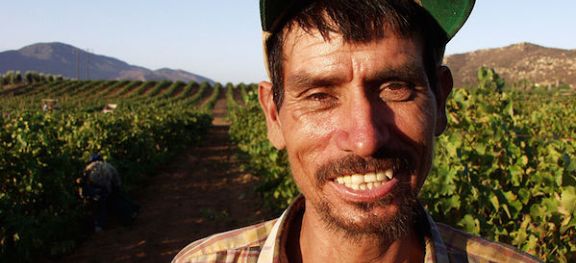Winegrowing in the wake of Trump

17 November 2016 We're making Alder's latest despatch from America free today as part of our Throwback Thursday series since it raises so many interesting questions about wine production worldwide, and exposes much intriguing detail about the mechanics of the California wine labour market. (The article was originally illustrated by a picture of the president-elect, until a Purple Pager asked us, via our members' forum, to change it.)
14 November 2016 Like many Americans, I’m still in shock. That our country has elected to its highest office someone I considered so completely unfit for public service has left me bitter and ashamed. I definitely haven’t moved past the second of the five stages of grief, having only in the past couple of days graduated from denial to smouldering anger.
Not only has Trump’s triumph in this election seemingly legitimised everything from deliberate ignorance to highly offensive, antisocial behaviours, it has threatened many of the fundamental tenets of what America has long represented to many of us. Standards of religious tolerance, multi-culturalism, environmental progress, and the rule of law are now seriously in question as we watch our president-elect assemble a cabinet of advisers and bureaucrats packed with some of the most radical demagogues this country has ever seen.
The outcome of this election has destroyed an incredible variety of hopes. Relevant to the world of wine, however, we no longer have even the shred of possibility for progress on the single most important issue facing most American winegrowers: comprehensive immigration reform.
The prospect of a Clinton presidency promised no easy solutions when it came to one of the most divisive issues in American politics, but there was a hope that her election, presumably with the support of a large number of Latino voters, would provide an opening for progress. Instead, pollsters and the public alike are left scratching their heads as Trump garnered a surprising portion of the Latino vote despite using the most virulently anti-immigrant rhetoric this country has heard in decades.
According to California State Senator Mike McGuire, who represents the entire region of California north of San Francisco, including Napa, Sonoma and Mendocino, his state is home to approximately three million undocumented workers.
‘About 68% of those who are undocumented in California are from Mexico', says McGuire. ‘Across the nation, about half are from Mexico and over 70% of the illegal immigrants in the United States are from Latin America. To put it in perspective, one in 10 workers in California are undocumented and, as far as we can tell, about 13% of all schoolkids in California have an undocumented parent.’
Everyone knows about the famous wall that Trump made such a centrepiece of his campaign, but less well known are his plans to dismantle much of the legal infrastructure that make up current immigration policy. In addition to declaring his intention to deport every single one of the more than 11 million immigrants living illegally in America (modified in the last 48 hours to be ‘two to three million lawbreakers initially’) Trump has set his sights on nothing less than repealing the 14th amendment of the US Constitution, which grants citizenship as a birthright to anyone born in this country. A true constitutional amendment change will require a two-thirds majority of both houses of Congress, but pundits worry there may be other legislative ways of accomplishing the same thing.
Trump will almost certainly immediately dismantle most of the progressive immigration policies of the Obama administration through executive orders, starting with the Deferred Action for Childhood Arrivals (DACA) programme, which eliminated the prosecution and deportation of illegal immigrants who came to the US before the age of 16. Trump’s plans also include increasing the price of, and reducing the availability of, many immigrant visa programmes, most notably the H-1B visa for skilled workers and the H-2A visas for temporary agricultural workers.
Those H-2A visas have been a mainstay of winegrower Steve Dutton’s labour force for several years. Dutton, one of the largest growers in Sonoma County, farms 1,400 acres (567 ha) of grapes and apples across northern California with the help of 120 employees, of whom two-thirds are brought into the US under the H-2A programme.
Under this programme, Dutton can bring in many workers for up to 10 months per year, but the terms under which he can do so are both pricey and complex.
‘It’s difficult', says Dutton. ‘Each year we have to get an immigration attorney, and pay her to process the contract with the Department of Labor and the Department of Immigration, which is a long process. This year, we were delayed. We start the process in November every year with the idea that we want our guys to be here by 1 April. This year, they didn't get here until 1 May so we were a month behind the whole year. It was just government delay. We contacted Senator Dianne Feinstein's office three times to get through the process to get them here by May.’
Getting the paperwork done is just the beginning. ‘Once we have the job certification order', says Dutton, ‘we have to go down to Tijuana [Mexico] and bring all of the guys to the American consulate to get each one of them their visa. They are fingerprinted and retinal scanned. Then we have to walk them across the border, and drive them up here to Sonoma in two busloads.’
In addition to the costs of setting up and administering the programme, Dutton is required to provide housing to every worker, to pay them at the Federal Adverse Wage Rate (which equates to $2 dollars more than minimum wage) and to provide health care for them under the Affordable Care Act.
‘Steve Dutton is one of the few growers in the county who can do this', says Senator McGuire when asked how many people utilise this programme. ‘It’s very expensive, and very clunky.’
The scale of Dutton’s operation, along with the dual nature of his crop, can justify the effort and costs required to utilise H-2A, but for the average winegrower farming a dozen acres, the programme remains unattainably expensive.
Agriculture in California alone is a $42.5 billion industry. ‘Go to the produce department in any American grocery store and almost every piece of fruit, vegetable or fruit in there was picked by hand', says Dutton. ‘And if you think for a second that more than one per cent of that was picked by American hands, you are dead wrong. 99% of those fruits and vegetables were picked with immigrant hands, coming, most likely, from Mexico or somewhere. Without this source of labour, we would be out of business.’
Much of the political rhetoric against immigration centres on the claim that illegal immigrants are taking jobs away from hard-working Americans. One of the other requirements for the H-2A visa programme forces Dutton to post advertisements for two days in three different newspapers in each of three different states for every job role he hopes to hire. If qualified Americans apply for the jobs, he must hire them.
‘Guess how many applications I have received in the few years I’ve been doing this programme?’ asks Dutton with a grimace. ‘Zero.’
‘Oh man', says Karissa Kruse, head of Sonoma County Winegrowers. ‘For about the last four years I’ve wanted to put an ad in the Wall Street Journal that says “Hey, you don't have a job? Come to Sonoma County. We have plenty of jobs, you're just going to have to work hard."’
Americans don’t want to do the hard labour of vineyard work, and certainly not for the going wage, which falls anywhere between $10 and $25 per hour.
The other typical charge against undocumented workers is that they come across the border for work, stay here, start families, and become a drain on the resources of their local economies.
‘Of all the guys that work for me, either on H-2A visas or working full-time, none of them are interested in being US citizens', says Dutton. ‘None. All they want to do is provide for their families back in Mexico, or provide for their families here.’
Because of the existing immigration laws, many workers don’t risk returning home to Mexico, even though they’d like to.
‘According to a survey we’ve done recently, about 88% of the vineyard workers in Sonoma County are residents in the county', says Kruse, ‘with about 75% of them having families here as well. It's not just the male worker going back and forth. They're here, their kids are in a school, their wives are looking for jobs or are at home taking care of their kids.’
As a result, most of Northern California’s wine country faces a housing crisis, but not of the type that most often makes news headlines. The problem is not the lack of housing in general, it is the lack of housing that someone making $20 an hour working in the vineyards can afford.
Organisations such as Kruse’s and every winegrower in the state find themselves caught between Scylla and Charybdis, battling first to find enough people to work in the vineyards, and then fighting to make sure they have somewhere to live while they keep California’s $32 billion dollar wine industry afloat.
Starting 21 January 2017, when Trump takes office, things are going to get a lot harder.
Photograph via Wikipedia.
Become a member to view this article and thousands more!
- 15,413 featured articles
- 274,243 wine reviews
- Maps from The World Atlas of Wine, 8th edition (RRP £50)
- The Oxford Companion to Wine, 5th edition (RRP £50)
- Members’ forum
- 15,413 featured articles
- 274,243 wine reviews
- Maps from The World Atlas of Wine, 8th edition (RRP £50)
- The Oxford Companion to Wine, 5th edition (RRP £50)
- Members’ forum
- Commercial use of our Tasting Notes
